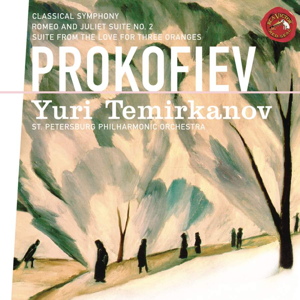
Sergei Prokofiev (1891-1953)
Symphony No. 1 “Classical”, in D major, Op. 25 (1917)
Romeo and Juliet Suite No 2, Op 64b (1935)*
The Love for Three Oranges Suite, Op 33a (1919-1924)
St. Petersburg Philharmonic Orchestra/Yuri Temirkanov
rec. 1991/1992*, Large Hall, St Petersburg Philharmonic; Blackheath Concert Halls, London*
Presto CD
RCA 09026 684082 [60]
This is a superficially attractive compilation of three of Prokofiev’s most attractive and accessible works, but comparison with previous classic and even vintage recordings reveals some deficiencies.
To start with the “Classical” Symphony, Nikolai Malko’s old recording shows the Philharmonia in 1955 to have been capable of a far perkier, more characterful reading – and I even prefer its early sound to the rather bland, homogenised, digital sound Temirkanov was given by RCA in 1991. The same is true of Sir Malcolm Sargent and the LSO from the late 50s on Decca, even though he is more leisurely. Finally, for good measure I reminded myself of Solti in Chicago, who dashes through the first movement in a manner antithetical to Sargent’s whimsical leisureliness, yet manages to be more interesting in the Larghetto – and the Chicago SO and the LSO are decidedly more opulent and virtuosic than the St Petersburg outfit. The Philharmonia for Malko is occasionally a bit raw but unlike Temirkanov and co., it is never dull. This might have something to do with how surprisingly recessed the digital recording is – but the reading itself lacks spice, too, I am sure. Temirkanov’s Gavotta limps rather than dances and by that stage I have lost interest in whatever he does with the finale, the performance as a whole being irretrievable in comparison with more illustrious predecessors (in fact, it is predictably routine). I generally love what Temirkanov does and can only ascribe this failure to a bad day and poor engineering.
The Romeo and Juliet Suite No. 2, I first compared with another vintage classic: the Mercury Living Presence recording of both suites by Skrowaczewski and the Minneapolis SO, who are again so much more immediate and compelling than Temirkanov for exactly the same reasons as his Classical Symphony pales. Skrowaczewski finds much more bite and intensity in the music, especially at such crucial points as the final “Romeo at Juliet’s tomb”, where the Minneapolis brass and percussion are compelling – and the dynamic range of the recording itself is much more apparent.
Which leaves The Love for Three Oranges. Once again, the sound seems to have been excessively equalised or compressed, so that by comparison the old 50s recordings by Malko and Sargent seem to leap out of the speakers; I can think of no reason why a listener would prefer Temirkanov’s digital account. I rather fear that this is one of those rare occasions where Presto’s generally commendable undertaking of reviving deleted recordings has not been worth the effort.
Ralph Moore
Help us financially by purchasing from



















